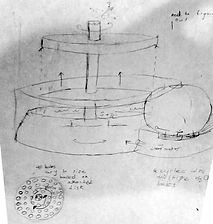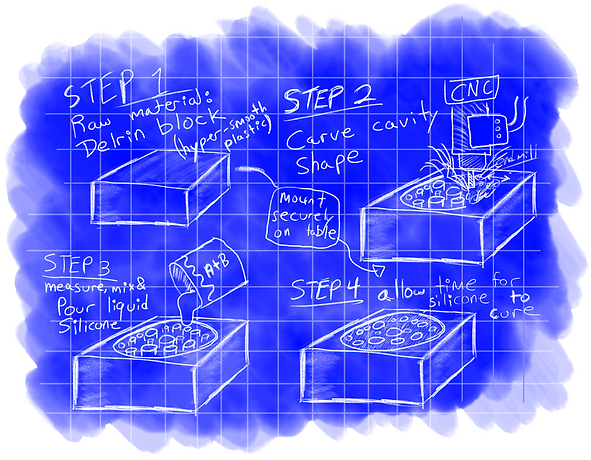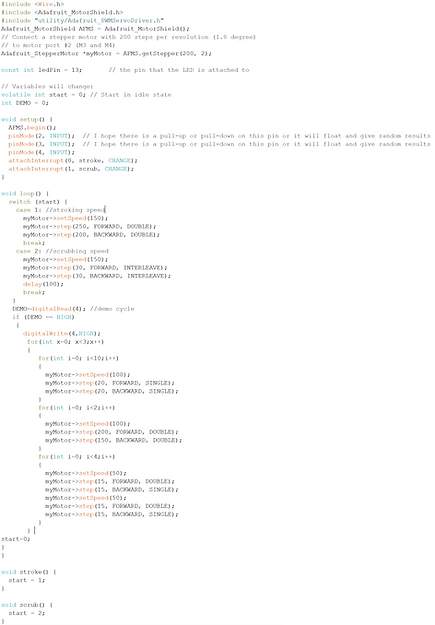
dawsoncannon


Morgantown
west virginia
SPRING 2013
Elective course - Mechatronics
Early in college, pure interest drove me to take an optional robotics class - the focus of which was the integration of mechanical systems and computer coding by means of circuit building.
Fast-forward to 2015. The very first night that the NOVA project was disclosed to me, the way that it could work popped into my head almost immediately.
Had I not fought to take this class, even though it was not required, my entire life would have turned out differently.
PREFACE
NOVA DESIGNS my first startup
"I was just the guy who could build the thing."
february
2015
-
Started in Junior Year of College
-
I was recruited by a friend whose sister had "the idea"
-
I sank my teeth into the opportunity, as a distraction from a personal trauma of the time
Tempe
Arizona
The Product?
A centrifugal washing machine for BULK COSMETIC MAKE-UP BRUSHES
-
The Sister, a cosmetologist, preached market viability
-
Research proved poor industry habits and rampant health risks
The Very First Night
MY INTERPRETATION


My humble Google SketchUp rendering that set the wheels in motion.
HER CONCEPTS



"Just Do It"
Ideas are great. But for anyone to care,
We would need a functional prototype.
I was a rookie diving into the prototyping process,
equipped with only the following:
-
SolidWorks 3D CAD Modeling Experience
-
Circuit building with Arduino processors and simple motors
-
Integrating hardware with tethered MATLAB programming

I was recruited to help because of my relative "know-how," but in the face of such an unwarranted endeavor, my skill set was still considerably lacking.
click for
sad article!


chandler
arizona
KNOW-HOW
meets CAN-DO
-
Open-access workshop
-
Heavy-duty fabricating equipment
-
Certification classes
-
Free for college students
Development began from scratch.
It was easy to know what I wanted,
but harder to determine what I would need.

EQUIPMENT
-
ShopBot CNC router tables
-
Thermal Vacuum Forming chamber
-
Makerbot 3D printer
-
Tap and Die set
-
PC for part design (CAD) and programming (Arduino C)
-
Soldering tools
materials
-
3D printer filament - ABS Plastic
-
A+B mixture cast-mold silicone
-
Plastic Delrin block (cast mold)
-
1/16" polypropelene sheets
-
Abrasive rubber surface
-
12V Power Supply
-
Arduino Uno + Motor Shield
-
NEMA size-23 hybrid stepper motor
-
Misc. electronic components (wires, buttons)
-
Misc. Standard hardware (small bolts, nuts, screws)
-
3/16" thick polyurethane baseplate (9" x 9" square)
solidworks
An ultimate software tool,
To become the bread and butter
of my career

Early rendition of mated components, providing an overall assembly idea
Fascinated by Solidworks, but deprived of it, the NOVA project gave me the opportunity to teach myself to a degree the university would have never offered me.
Through engineering school, I always knew of this incredible CAD software. However, it had only ever been glossed over as a topic.
REWIND: My first time seeing a SolidWorks design come to life was in Mechatronics class. My custom sensor mounts came off of a 3D printer that was hidden from sight in a closet somewhere.
To sketch and design in two and three dimensions, and hold it in my hand shortly after, was a feeling that would stay with me.

I needed such a powerful motor due to the frictional nature of the device, dragging brush heads across an abrasive surface below. This NEMA 23-size hybrid stepping motor can be used as a unipolar or bipolar stepper motor, with a 1.8° step angle (200 steps/revolution). Each phase draws 1 A at 5.7 V, allowing for an extremely strong holding torque of 4 kg-cm (55 oz-in).

Using vernier calipers, I measured the selected motor down to a tee. From there I was able to design this custom mount and 3D print it for use in the prototype.

The "Suspension Disk" assembly was made up of many parts. Highlighted in this image is the tiny plastic cap (top) covering an inset bolt, which would be tightened so that small "teeth" (bottom) would bite into the underside of the rubber suspension disk. (not shown) This would keep the soft rubber bound to the hard plastic parts, standing up to the motor's sporadic torque output.

I needed such a powerful motor due to the frictional nature of the device, dragging brush heads across an abrasive surface below. This NEMA 23-size hybrid stepping motor can be used as a unipolar or bipolar stepper motor, with a 1.8° step angle (200 steps/revolution). Each phase draws 1 A at 5.7 V, allowing for an extremely strong holding torque of 4 kg-cm (55 oz-in).
Computer renderings are a great visual tool, but alone they can only take a project so far.
creation:
flying blind
Learning the CNC Routing Table

The local TechShop facility had multiple CNC tables available for use, following completion of their certification class.
Nothing created with the CNC table would be directly used in the prototype!
Instead, it was used only for creating molds and plugs, a.k.a. custom tools, larger than what a 3D printer was capable of creating.


CNC USE #1,
Mold-making for the "Suspension Disk",
the perforated rubber disk responsible for supporting all the brushes in the cleaning area.

The "Suspension Disk" after curing and removing from the delrin mold.

SUSPENSION DISK ASSEMBLY:Design decisions
-
Largest brush slots on outside, smallest on inside for space optimization and relative brush cleaning velocities (bigger needs faster)
-
3-arm support inset into underside of disk, adds rigidity, prevents silicone droop
-
Central through-hole, single bolt clamps down to form solid assembly
CNC USE #2,
Plug-making for the lower enclosure and cleaning tray.
I designed the unique surfaces that would make up the body of the device, but had no clue how to physically create these shapes that were to be thin and hollow.
What is a plug?
Plugs are essentially a type of mold. Instead of using a negative cavity to create a positive solid, you start with a positive solid that can give you infinite positive surfaces.

Learning the Thermal Vacuum Former



SOLUTION:
Redesign from thin surfaces to whole solids, and account for sheet material thickness.

When using a vacuum former, plugs are lowered into an air-tight chamber while a sheet of plastic is heated above.
When the plastic sheet reaches an optimal temperature, the plug is vertically lifted into the sheet while the air is vacuumed out from below.
This very quickly reshapes the plastic over the plug!
The scrap material can either be cut away with CNC or by hand.
Then, export topographical data for a 3D CNC operation to acquire positve solids.
The only material that came thick enough to make a plug tall enough for my base design was foam. However, foam was not strong enough to withstand the many forces involved in vacuum forming.
MDF wood, the best alternative, was only available in a maximum thickness of one inch. So, I had to get even more creative.

Lower enclosure after being thermoformed over the plug
Programming was a greater challenge. I wrote the first code using MATLAB software, since it was what I knew.
Later, I realized that this software combined with the Arduino hardware would require a wired connection to a computer in order for the prototype to operate.
Circuit building, the physical act of it, was a favorite activity. It was hands-on with real world applications, calling for dormant soldering skills that were fun to practice and improve upon.
electronics




In order to get the prototype to operate as a freestanding unit, it would require learning C++, a different coding language better suited for the selected Arduino processor.
A freestanding prototype would be the best way to convey the legitimacy of such an idea to a group of investors or whoever.
The secret ingredient to cosmetic brush cleaning already existed all over the internet.
Silicone Brush Cleaning Mats
saturated online marketplaces as the ultimate analog brush cleaning solution.
By programming the motor to oscillate back and forth, all that remained was a surface for the dirty brush heads to be scrubbed against.
The prototype was nearly complete.
brush cleaning

My custom mat design is distinguished by two regions that corresponding to brush size
inside: small, fine-tip accent brushes
outside: larger bushier brushes

Sigma Beauty brush cleaning mat suctions to sinks, variety of textures correspond to various brush types.

Generic sheet of silicone bristles cut to fit the prototype for testing

april
2015

I spent the second semester of my junior year in college immersed in the technical design process of this "personal" non-school related project.
In this short span, my G.P.A. plummeted from a 3.9 to a 3.3
OAKLAND
INTERNATIONAL
AIRPORT

Hand-delivered
My involvement in this passion project earned me a plane ticket to Silicone Valley, where the prototype would be pitched to one specific investor...
Upon visitation and overwhelming thank you's, the prototype was left with the tearful sister whose idea it was that sparked the effort.
continuity check
For the next year, I would be finishing my engineering degree.
A couple things happened before I would ever see the Nova project again.
April 1, 2015
applies for provisional patent
on NOVA device
March 2016
Device presented
to Bay Area focus group, without Dawson.
one year later...
Enthusiasm for this project carried on within me. In a now-or-never moment, I dropped out of my accelerated Master's degree track at ASU.
(I still left with my bachelor's.)
I was invited by my enthusiastic friend and his generous family
to move to his home town in California;
for the purpose of finishing the good work that was started with the Nova Makeup Brush Cleaner.
To the tune of developing the product and business, as a team, with promises of focus groups, engineering, and venture capital.
JUNe
2016
dublin
california




Now A legal partner
of a family trio, everything quickly turned political.
The siblings' father invested $10,000 on concept sketches from the first company in the Google search results.
Later, he used LegalZoom to file for incorporation on all our behalfs. I was assigned as the lowest ranking position on the barren officer template.
In the months preceding my graduation, the prototype, back in California, had been taken to a Product Development firm called FocusPDM
I made the move ready to work.
One night, I was working on an overhaul to the Nova brush cleaner design. I knew that I could make it more streamlined and presentable for pitches of all types. The father caught me doing this, and quite angrily stopped me in my tracks. He claimed that he was "taking care of it."
I argued.
I had moved out of college to see this project through, but I was the only one who seemed interested in making any real progress.
But now my ambition was being suppressed by the team that brought me there?
Months carried on with no news from him, or the group that he hired. Every time I asked for updates, I was met with dismissal and scorn.
What was taking so long? Why did this strange company still have my prototype?
What was I even doing here?
Brewing in frustration,
I drove to the firm on my own in search of answers and my beloved creation.
san mateo
california
What I found was unsettling. The facility, filled with workstations and whiteboards, was completely empty. Mid-day, mid week, devoid of all life and employees.
I reported this back to my team, at first met with anger towards how I took it upon myself to investigate. There was poor reception to my lone-wolf approach.
However, I was only present to execute on this project.
I couldn't keep sitting around.
In response, their father called the owner of the firm, the same contact he had got the concept drawings from. A meeting was scheduled where we would all be present with the prototype.
When we all went back for the meeting, it was a familiar sight. A desolate office area, but now present with the CEO of the business.

The meeting was enlightening
with several key takeaways...
-
The facility was empty because of a mass layoff. The firm was in trouble, despite a bustling atmosphere when the prototype was first dropped off.
-
Their father had invested the $10,000 unaware that this was on the horizon.
-
Now, the owner was quoting about $250,000 more in order to get the Nova product refined, produced, and mass-market ready via his "services."
-
My team was ready to give up.
What was next? Crowdfunding? Venture Capital? A miracle?

After all, I was just the guy who could build the thing.
Amid discouraging circumstances, I wasn't ready to give up. I strongly believed in her idea, my device, and the business potential behind it.
To my partners, raising $250,000 was an impossible task. While they played along with my own tenacity, they had ultimately given up and started to move on, right in front of me.
Meanwhile, I knew that if we were to get an investment of any size, it was going to take a comprehensive business plan.
I was the only one willing to take that on.
September 2016
going out
swinging



I spent every free second of September 2016 writing up this business plan.
I took what I learned from my Study Abroad class and worked my fingers to the bone.
Every lunch break, every night until the early morning. Straight through my 23rd birthday, nonstop.
At times, the walls of my apartment were covered with draft pages I had taped up to help me organize progress.
All with no help from my supposed partners. They stood speechless at the drafts that hung on the wall,
pretending it wasn't happening.
I completed it on September 30th, and no one involved even cared to read it.
A learning experience
reflecting on my naivety
Fresh out of college, I took an unprecedented risk that very few people do.
I fell in love with the process of design and creation, and for a multitude of complex reasons, I was convinced that a conventional route would fail to fulfill me.
I built this makeup brush cleaner in the Spring of 2015, largely impressing the others who were involved. Many promises were made to me, which shaped my expectations as I dove into the unknown.
Expectations
-
Build a business and a brand around a product idea
-
Hit the ground running as a team
-
Full-time effort and cooperation
-
A coherent decision-making process
-
Calculated resources and substantial investing from everyone involved
-
Active involvement in design and engineering with a professional firm
Reality
-
Outworking everyone involved
-
Neglected as an insightful contributor
-
Preemptive investment mistakes with a poorly suited product firm
-
Being ordered to not work on the thing
-
Team motivation plummeting after first obstacle
-
External pressure to give up and get a job
Outcome
-
An important friendship would begin to suffer
-
Early 20's living in a remote suburb for no reason
-
I knew I could build a product
-
I knew I could write a business plan
-
I knew that I loved it
-
I knew that I wasn't going to give up
Where could it have gone?

Some solidworks modeling I did later on, just for fun...


